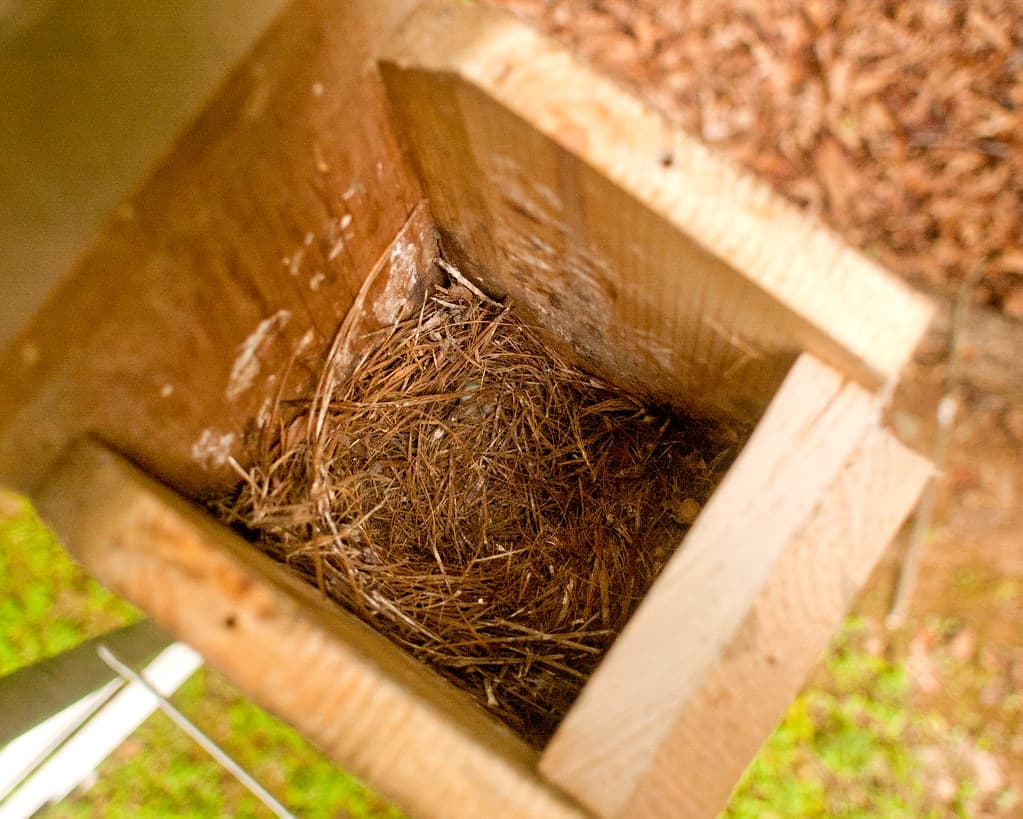
So, a pair of bluebirds found your nest box. Over the course of a few months they’ve laid eggs, raised their young, and they’ve finally flown away. Congrats! You’re a successful bluebird landlord. But now what do you do with the nest? This is exactly what I was wondering when I attracted my first pair of bluebirds to my backyard sixteen years ago. Should I remove the old nest and clean out the nest box, or should I leave the nest alone and let the bluebirds handle things from here? Maybe you’re asking yourself the same thing.
The above photo by tommaync is licensed under CC BY-NC-SA 2.0
What To Do When Bluebirds Leave The Nest
When bluebirds finally leave the nest, remove the old nest and dispose of it in a different location. Once you have removed the old nest, sweep the nest box of any debris and close it up. It will now be ready for the adult bluebirds to build another nest.
Why should I remove the old nest after the bluebirds leave?
Interestingly, certain studies show that bluebirds like to build their second nest on top of their first nest, while other studies show the opposite, that bluebirds prefer to build their second nest in a clean nest box. So, why do I recommend the latter option? I recommend removing the old nest after bluebirds leave for three reasons:
- Removing the old nest protects the nestlings from predators by increasing the distance between the entrance hole and the new nest.
- Some studies show that bluebirds prefer to build their second nest in a clean nest box.
- Removing the old nest helps protect bluebird nestlings from blowfly larvae and other harmful pests.
1. Removing the old nest protects bluebirds from predators
If you leave an old nest in your bluebird house, bluebirds will have to build their second nest on top of their old nest. If this happens, the top of the nest will now be closer to the entrance hole, making the bluebird nestlings more vulnerable to predators. With the nest closer to the entrance hole, predators like cats and raccoons, who love to reach into nest boxes, will have easier access to the bluebird nestlings and eggs. This is one of the main reasons I recommend removing the old nests after bluebirds leave the nest.
The Michigan Bluebird Society recommends a 5-6″ distance from the bottom of the entrance hole to the floor of your bluebird house (source). This distance will decrease the likelihood of predators being able to reach your bluebirds. So, removing the old nest after bluebirds leave will help maintain a safe distance between the entrance hole and the nest, keeping future nests of bluebirds safer from predators.
2. Some bluebirds prefer to build new nests in a clean nest box
In nature, when bluebirds find a natural cavity to nest in (such as in an old tree or fence post), no one is going to clean out their old nest. So, bluebirds will naturally build a second nest on top of their old one. But, when given the option, some studies show that bluebirds prefer to build their new nests in a clean nest box.
In a study out of North Carolina, researchers put up 100 nest boxes. After bluebirds fledged their first nests of the year, the researchers removed half of the old nests and left half of the nests alone. The result was that 71% of the bluebirds studied chose to move to a clean nest box for their second nest instead of building on top of an old nest (source).
3. Removing the old nest after bluebirds leave can protect bluebirds from blowfly larvae
Another benefit of removing the old nest after bluebirds leave is that it can protect the new nest of bluebirds from blowfly larvae and other parasites. Blowfly larvae are a common parasite that you might find in your bluebird nests occasionally. Fortunately, the cleaner and dryer a nest is, the less likely it is that it will become infested with blowfly larvae. Like Sialis.org recommends, set up your bluebirds for success by removing the old nest after bluebirds leave, as this can deter blowfly larvae and other parasites (source).
Should I sanitize the nest box each time bluebirds fledge?
So, we know that there are some proven benefits to cleaning out the nest box after bluebirds leave. But, should you go a step further and sanitize the nest box after you remove the nest? The answer is no. You do not need to fully sanitize the nest box after each time your bluebirds fledge. All you need to do is remove the nest, sweep out the debris, close the box, and you’re ready for the next nest of bluebirds.
You should, however, consider sanitizing the nest box at the end of the nesting season.
What to with your nest box at the end of the season
At the end of the nesting season, I recommend cleaning out your bluebird houses and doing a deep-clean to sanitize the nest boxes for the following year. Sanitizing your nest boxes is a good way to wrap up the season and wipe out anything in the nest box that might attract parasites. It’s good practice to do this once a year, just to be safe, even if you haven’t had problems with parasites.
Sanitizing your nest boxes can be as simple as wiping them out with a 10% bleach solution. A homemade solution is fine, or you can go with something like Clorox Cleanup (here’s a link to it on Amazon). After wiping down the inside surfaces of your bluebird house, let it air out for 24 hours before closing the box up for the winter.
Update: I wrote a full step-by-step guide for cleaning out your bluebird house at the end of the nesting season (cleaning, sanitizing, etc.) Click here to read that article.
Conclusion
Now, I hope it’s clear what to do when bluebirds leave the nest. Essentially, remove the nests after each brood of bluebirds fledge. Then, clean out and sanitize your nest boxes at the end of the season. It’s as simple as that.
If you’re looking to put up your first bluebird house, or if you just need a new best box, check out my Recommended Tools page to see the nest boxes that I use.

